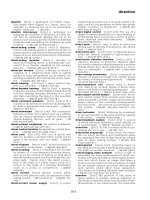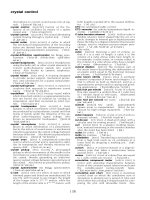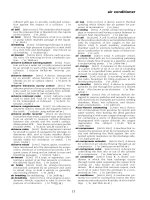Cutting Tools Episode 1 Part 7 pps
Bạn đang xem bản rút gọn của tài liệu. Xem và tải ngay bản đầy đủ của tài liệu tại đây (399.16 KB, 5 trang )
Cutting
Tool
Applications
Cutting Tool Applications
By George Schneider, Jr. CMfgE
www.toolingandproduction.com
Chapter 7/Tooling & Production
1
7.1 Introduction
Both the shaper and the planer are single point tools and cut only in straight lines. They
both make the same types of cuts.
The shaper handles relatively small work. The planer handles work weighing up to
several tons. The cutting stroke of the shaper is made by moving the tool bit attached to
the ram. The cutting stroke of the planer is achieved by moving the work past a station-
ary tool bit.
The types of cuts which can be made with either machine are shown in Figure 7.1.
Both the shaper and
the planer usually cut
only in one direction,
so that the return
stroke is lost time.
However, the return
stroke is made at up
to twice the speed of
the cutting stroke.
7.2 The Shaper
The shaper is a rela-
tively simple
machine. It is used
fairly often in the
toolroom or for
machining one or
two pieces for proto-
type work. Tooling
is simple, and
shapers do not
always require opera-
tor attention while
cutting. The horizon-
tal shaper is the most
common type, and its
principal components
are shown in Figure
7.2, and described as
follows:
Chapter 7
Shaping
& Planing
Upcoming Chapters
Metal Removal
Cutting-Tool Materials
Metal Removal Methods
Machinability of Metals
Single Point Machining
Turning Tools and Operations
Turning Methods and Machines
Grooving and Threading
Shaping and Planing
Hole Making Processes
Drills and Drilling Operations
Drilling Methods and Machines
Boring Operations and Machines
Reaming and Tapping
Multi Point Machining
Milling Cutters and Operations
Milling Methods and Machines
Broaches and Broaching
Saws and Sawing
Abrasive Processes
Grinding Wheels and Operations
Grinding Methods and Machines
Lapping and Honing
George Schneider, Jr.CMfgE
Professor Emeritus
Engineering Technology
Lawrence Technological University
Former Chairman
Detroit Chapter ONE
Society of Manufacturing Engineers
Former President
International Excutive Board
Society of Carbide & Tool Engineers
Lawrence Tech.Univ.:
Prentice Hall:
FIGURE 7.1: Typical cuts made by both shapers and planers.
Chap. 7: Shaping & Planing
2
Tooling & Production/Chapter 7
www.toolingandproduction.com
Ram: The ram slides back and forth
in dovetail or square ways to transmit
power to the cutter. The starting point
and the length of the stroke can be
adjusted.
Toolhead: The toolhead is fastened
to the ram on a circular plate so that it
can be rotated for making angular cuts.
The toolhead can also be moved up or
down by its hand crank for precise
depth adjustments.
Attached to the toolhead is the tool-
holding section. This has a tool post
very similar to that used on the engine
lathe. The block holding the tool post
can be rotated a few degrees so that the
cutter may be properly positioned in the
cut.
Clapper Box: The clapper box is
needed because the cutter drags over the
work on the return stroke. The clapper
box is hinged so that the cutting tool
will not dig in. Often this clapper box is
automatically raised by mechanical, air,
or hydraulic action.
Table: The table is moved left and
right, usually by hand, to position the
work under the cutter when setting up.
Then, either by hand or more often
automatically, the table is moved side-
ways to feed the work under the cutter
at the end or beginning of each stroke.
Saddle: The saddle moves up and
down (Y axis), usually manually, to set
the rough position of the depth of cut.
Final depth can be set by the hand crank
on the tool head.
Column: The column supports the
ram and the rails for the saddle. The
mechanism for moving the ram and
table is housed inside the column.
Toolholders: Toolholders are the
same as the ones used on an engine
lathe, though often larger in size. The
cutter is sharpened with rake and clear-
ance angles similar to lathe tools,
though the angles are smaller because
the work surface is usually flat. These
cutters are fastened into the toolholder,
just as in the lathe, but in a vertical
plane.
Work Holding: Work holding is fre-
quently done in a vise. The vise is spe-
cially designed for use in shapers and
has long ways which allow the jaws to
open up to 14 inches or more, therefore
quite large work pieces can be held.
The vise may also have a swivel base so
that cuts may be made at an angle.
Work which, due to size or shape, can-
not be held in the vise, is clamped
directly to the shaper table in much the
same way as parts are secured on
milling machine tables.
Shaper Size: The size of a shaper is
the maximum length of stroke which it
can take. Horizontal shapers are most
often made with strokes from 16 to 24
inches long, though some smaller and
larger sizes are available. These shapers
use from 2 to 5 HP motors to drive the
head and the automatic feed.
Shaper Width: The maximum width
which can be cut depends on the avail-
able movement of the table. Most
shapers have a width capacity equal to
or greater than the length of the stroke.
The maximum vertical height available
is about 12 to 15 inches.
7.2.1 Drive Mechanisms
Shapers are available with either
mechanical or hydraulic drive mecha-
nisms. Figures 7.3a and 7.3b show dia-
grams of both shaper drive mechanisms.
Mechanical Drive
The less expensive shaper, the one most
often purchased, uses a mechanical
drive. This drive uses a crank mecha-
nism (Fig. 7.3a). The bull gear is driven
by a pinion which is connected to the
motor shaft through a gear box with
four, eight or more speeds available.
The RPM of the bull gear becomes the
strokes per minute (sometimes abbrevi-
ated SPM) of the shaper.
Cutting Speed: The cutting speed of
the tool across the work will vary during
the stroke as shown by the velocity dia-
gram in Figure 7.3a. The maximum is
at the center of the stroke. However, if
the cutting speed chosen is somewhat
on the slow side, the average speed may
be used, and computations are greatly
simplified.
Although the ratio varies some-
what,several shapers have a linkage
using 220 degrees of the cycle for the
cutting stroke and 140 degrees for the
return stroke. This is close to a 3:2
ratio.
In setting up a mechanically operated
shaper, the length of cut (in inches) is
known, and the cutting speed (in feet
per minute) is selected according to the
kind of metal being cut. It is then nec-
essary to compute the strokes per
minute since that is how the shaper
speed is controlled. Such calculations
are beyond the scope of this text.
The stroke per minute available on a
shaper will vary according to the size of
the shaper. The larger shapers will have
lower speeds. A 16 inch shaper may
have speeds of 27 to 150 strokes per
minute, while a 24 inch shaper will have
10 to 90 strokes per minute speeds
available.
FIGURE 7.2: The horizontal shaper is the most common type; its princpal components
are shown here (Courtesy: Cincinnati Machine)
Chap. 7: Shaping & Planing
www.toolingandproduction.com
Chapter 7/Tooling & Production
3
Cutting Feed: Feed per stroke on a
shaper is comparable to the feed per
revolution on a lathe. Coarse feeds for
roughing range up to 0.100 inch per
stroke (sometimes abbreviated as IPS),
and finish cuts from 0.005 to 0.015 inch
per stroke. Finish would also depend on
the nose radius of the cutting tool.
Hydraulic Drive
The hydraulic shaper (Fig. 7.3b) has the
same major parts as the mechanical one,
however, the ram is driven by a
hydraulic cylinder as shown in the sim-
plified sketch. These shapers use 5 to
10 HP motors.
Cutting Speed and Feed: The cut-
ting speed of the hydraulic shaper is
infinitely variable by means of
hydraulic controls, as is the
cross feed. The reverse
stroke is made faster than
the power stroke because of
the smaller area in the return
side of the cylinder, if a con-
stant volume pump is used.
Another method is to have
the rate of fluid flow
increased to speed up the
return stroke.
Speed and feed on a
hydraulic shaper are often
controlled by simple dials.
Speed is read directly in feet
per minute and feed is read
directly in decimal inches.
The cutting speed remains
nearly constant through the
full stroke.
7.2.2 Vertical
Shapers
The vertical shaper,
sometimes called a
slotter, has a verti-
cal ram, with table
and saddle similar
to the horizontal
shaper. If a rotary
table is mounted on
the regular table, a
number of slots can
be made at quite
accurately spaced
intervals. This
machine can work
either outside or
inside a part, pro-
vided that the inte-
rior opening is larg-
er than the tool
head. A schematic illustration
of a vertical shaper is shown in
Figure 7.4.
7.3 The Planer
A planer makes the same types
of cuts as a shaper. However,
it is a production-type machine
for certain types of work. It
can machine any flat or angu-
lar surface, including grooves
and slots, in medium and large
sized workpieces (see Fig.
7.1). Typical work would be
machine beds and columns,
marine diesel engine blocks,
and bending plates for sheet
metal work. These parts are
usually large iron castings or
steel weldments and may weigh a few
hundred pounds or several tons.
The most frequently used type of
planer is the double-housing planer,
shown in Figure 7.5, with the following
components:
Frame: The frame is basically two
heavy columns fastened together at the
top with a large bracing section and fas-
tened at the bottom to the machine bed.
This creates a very strong, rigid struc-
ture which will handle heavy loads
without deflection.
Crossrail: The crossrail is also a
heavy box, or similar construction. It
slides up and down on V- or flat ways,
controlled by hand or by power-operat-
ed screws. These crossrails are so
heavy that they are counterweighted,
Ram connection
Max. forward
position
Rocker arm
Bull gear
sliding block
Adjusting
screw
Crank pin
Pivot bearing
(a)
Max. rear
position
Bevel gears
(stroke
adjustment)
Bull gear
Cut
Stroke length
Velocity diagram
Velocity
40°
Cutting
stroke
220°
140°
Return
stroke
1.0
1.6
R
e
t
u
r
n
Velocity diagram
Forward cutting speed
Return speed (b)
Velocity
Return
stroke
(faster)
Shaper ram
Cutting
stroke
4-way
valve
Pump
Tank
Motor
Base
Ram with annular
adjustment
Drive gear
box
Longitudinal feed
Tool holder
Rotating table
Table rotation
Transverse
feed
FIGURE 7.3: Shapers are available with either (a)
mechanical drive mechanisms or (b) hydraulic drive
mechanisms.
FIGURE 7.4: Schematic illustration of a vertical
shaper, also called a slotter.
Clapper box
Crossrail
Top brace
Rail head
Bed
Drive motor
Column or housing
Side head
Table
Bed
Vee ways
FIGURE 7.5: Schematic illustration of a double-
housing planer.
Chap. 7: Shaping & Planing
4
Tooling & Production/Chapter 7
www.toolingandproduction.com
with either cast iron weights or
hydraulic cylinders, in order that they
may be moved easily and positioned
accurately. After being positioned, they
are clamped in place.
Railheads: The two railheads can be
moved left or right across the crossrail,
each controlled by a separate lead
screw, which can be turned by hand but
usually by power feed. The railhead can
be rotated, and vertically adjusted for
depth of cut, the same as the shaper
heads. They also have a clapper box
(often with power lift) like the shaper.
Sideheads: The sideheads are inde-
pendently moved up or down by hand or
by power feed and can also be rotated
and moved in or out for depth of cut.
Table: The table is a heavy casting
which carries the work past the cutting
heads. It runs on V- or flat ways. The
table is driven either by a very long
hydraulic cylinder or by a pinion gear
driving a rack which is fastened under
the center of the table. The motor dri-
ving the pinion gear is the reversible
type with variable speed.
Bed: The bed of the planer must be a
weldment or casting twice as long as the
table. Thus a 12-ft table requires a 24-
ft bed. The gearing of hydraulic cylin-
ders for driving the table is housed
under the bed.
Toolholders: Planers use high speed
steel or carbide tipped cutting tools sim-
ilar to those used on shapers. However,
since planers make heavy cuts, their
tools are much larger. Rake relief
angles are similar to those used on lath-
es for cutting cast iron or steel, although
relief angles are often only 3 to 5
degrees, because all cuts are on flat sur-
faces.
Work Holding: Holding the work
while machining such heavy cuts at 60
to 100 feet per minute requires consid-
erable force; therefore, the workpieces
must be solidly fastened to the table.
Because the reversal of direction occurs
quite rapidly, the work must be espe-
cially well braced at the ends. The table
has T-slots, both lengthwise and across,
in which heavy bolts and clamps may be
used. Sometimes holes are drilled in the
table so that large pins can be used to
prevent the workpiece from going off
the table when the machine reverses.
Planer Size: The size of planers is
often referred to as a 30 inch planer or a
60 inch planer. This specifies the
approximate width of the table which
ranges from 30 to 72 inches. A more
complete specification is:
Width of table x height under rail
x length of table
(For example: 48 inches x 48 inches
x 14 feet)
The width and height are usually, but
not always, the same. Table length is
often made to order and may be as short
as 8 feet, or as long as 20 feet or more.
The drive may be 15 HP on the smaller
planers, and 100 HP or more on the
larger models.
Mechanical and hydraulic power can
be used for planers. Uniform cutting
speed is attained throughout the cutting
stroke. Acceleration and deceleration of
the table takes place in a short distance
of travel and does not influence the time
to machine.
Double-housing Planers: Double-
housing planers consist of a long heavy
base on which the table reciprocates.
The upright housing near the center on
the side of the base, supports the cross-
rail on which the tools are fed across the
work. Figure 7.5 illustrates how the
tools are supported both above and on
the sides, and their adjustment for angle
cuts. They are fed by power in either a
vertical or a crosswise direction.
Open-sided Planers: Open-sided
planers have the housing on one side
only. The open side permits machining
wider workpieces. Most planers have
one flat and one double V-way, which
allows for unequal bed and platen
expansions. Adjustable dogs at the side
of the bed control the stroke length of
the platen.
Planers are often converted to planer-
mills, for more efficient machining.
7.3.1 Comparison of Shapers
and Planers
Although both the planer and the shaper
are able to machine flat surfaces, there
is little overlapping in their application.
They differ greatly in construction and
in the method of operation. The planer
is especially adapted to large work: the
shaper can do only small work. On the
planer the work is moved against a sta-
tionary tool: on the shaper the tool
moves across the work, which is sta-
tionary. On the planer the tool is fed
into the work; on the shaper the work is
usually fed across the tool. The drive on
the planer table is either by gears or by
hydraulic means. The shaper ram also
can be driven in this manner, but many
times a quick-return link mechanism is
used.
Most planers differ from shapers in
that they approach more constant-veloc-
ity cutting speeds. Tools used in shaper
and planer work are single point as used
on a lathe, but are heavier in construc-
tion. The holder is designed to secure
the tool bit near the centerline of the
holder or the pivot point rather than at
an angle as is customary with lathe tool-
holders.
Cutting tools for the planer operation
are usually tipped with high-speed steel,
cast alloy, or carbide inserts. High
speed steel or cast alloys are commonly
used in heavy roughing cuts and car-
bides for secondary roughing and fin-
ishing.
Cutting angles for tools depend on
the tool used and the workpiece materi-
al. They are similar to angles used on
other single-point tools, but the end
clearance does not exceed 4 degrees.
Cutting speeds are affected by the rigid-
ity of the machine, how the work is
held, tool, material, and the number of
tools in operation. Worktables on plan-
ers and shapers are constructed with T-
slots to hold and clamp parts that are to
be machined.









